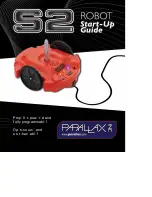
“It Doesn’t Go!”
Since your SolarSpeeder uses a relatively simple circuit, there are only a few things that
can go wrong. Go through the list and see if any of these answers fix it:
• Transistor/Trigger Placement and Orientation.
Make sure
that they’re facing the
correct directions, as they all don’t face up. With your SolarSpeeder sitting on its
wheels, make sure that:
- The transistor at the nose is the 3904 and facing
down.
----- The transistor on the left is the 3906 and facing is facing
up.
- The transistor on the right is the 1381 trigger facing
up.
•
••
•
• Perform a ‘wiggle’ test on all the components. That is, grip each of the components
on the PCB and give it a firm wiggle. Closely watch where the wire legs are soldered to
the PCB. They all must be firmly soldered to the pads, and not sliding through the
holes at all. THIS WILL DETECT THE MAJORITY OF PROBLEMS!
•
••
•
• There
cannot
be anyjumpers between the solder pads. These are blobs of solder
that cross from one pad to the next and short out the electronics. Examine the sets of
three pads that each of the transistors are attached to - these are most likely to have
solder jumpers.
• Make sure that the red motor wire is soldered to the correct pad on the main body of
the PCB.
• Are the wire connections to the solarcell still good? A
gentle
tug on the wire will be
enough to check this. If it comes loose, you probably have a wrecked solarcell solder
pad. If you want to try to salvage the solarcell, try using automotive defogger paint, or
a conductive ink pen.
• Lift the solarcell off the surface of the PCB - does it work now? You may be accidently
shorting the electronics with one of the solarcell solder pads. Cover it with some tape
or make sure it’s insulated from the PCB with glue.
• Prop the SolarSpeeder up so the drivewheel is suspended off the ground. Does it run
now? If so, check the drag on the other two wheels. You should be able to give your
SolarSpeeder a flick with your finger and it should roll at least 15cm (6”).
If nothing else, you can send it back to Solarbotics for free repair (or replacement if
necessary). We stand 100% behind our products, and will do everything we can to
make your kit perform like it should.
“It Doesn’t Roll Smoothly!”
If something is rubbing, chances are it will be
the storage capacitor. You can make more clear-
ance underneath your SolarSpeeder by bending
the drive motor downward.
12































